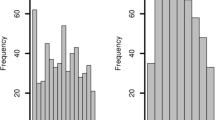Abstract
Age estimation is one of the primary demographic features used in the identification of juvenile remains. Determining the accuracy and repeatability of age estimations based on postmortem computed tomography (PMCT) data compared with those using conventional orthopantomography (OPT) images is important to validate the use of PMCT as a single imaging technique in forensic and disaster victim identification (DVI). In this study, 19 juvenile mandibles and maxilla of known age underwent both OPT and PMCT. Three raters then estimated dental age using the resulting images and 3D reconstructions. This assessment showed excellent agreement between the age estimations using the two techniques for all three observers. PMCT also offers a greater range of measurements for both the dentition and the whole human skeleton using a single image acquisition and therefore has the potential to improve both the speed and accuracy of age estimation.






Similar content being viewed by others
References
United Nations declaration of human rights [Internet] (2012) last accessed 2012 Jul 2. Available from: http://www.un.org/en/documents/udhr/
Scheuer L, Black S (2000) Developmental juvenile osteology. Academic Press, San Diego
Olze A, Niekerk PV, Schulz R, Ribbecke S, Schmeing A (2012) The influence of impaction on the rate of third molar mineralisation in male black Africans. Int J Legal Med 126(4):615–621
Thevissen PW, Kaur J, Wilems G (2012) Hunam age estimation combining third molar and skeletal development. Int J Legal Med 126(2):285–692
Thevissen PW, Galiti PW, Willens G (2012) Human dental age estimations combining third molar(s) development and tooth morphological age predictors. Int J Legal Med 126(6):883–887
AlQahtani SJ, Hector MP, Liversidge HM (2010) Brief communication: atlas of tooth development and eruption. Am J Phys Anthropol 142:481–490
Atlas of tooth development and eruption [Internet] (2012) last accessed 2012 Aug 14. Available from http://www.dentistry.qmul.ac.uk/atlas%20of%20tooth%20development%20and%20eruption/index.html
Demirjian A, Goldstein H (1976) New systems for dental maturity based on seven and four teeth. Ann Hum Biol 3(5):411–421
Demirjian A, Goldstein H, Tanner JM (1973) A new system of dental age assessment. Hum Biol 45:211–227
Ubelaker DH (1978) Human skeletal remains: excavation, analysis and interpretation. Aldine Publishing Compant; Chicago. CRC Press
Mincer HH, Chaudhry J, Blankenship JA, Turner EW (2008) Postmortem dental radiography. J For Sci 53(2):405–407
Gruber J, Kameyama MM (2001) Role of radiology in forensic dentistry. Braz Oral Res 15(3):263
Verhoff MA, Ramsthaler F, Krahahn J, Deml U, Gille RJ, Grabherr S et al (2008) Digital forensic osteology—possibilities in cooperation with the virtopsy project. Forensic Sci Int 174:152–156
Rutty GN, Robinson C, Morgan B, Vernon L, Black S, Adams C et al (2009) Fimag: the United Kingdom disaster victim/forensic identification imaging system. J Forensic Sci 54(6):1438–1442
Thali MJ, Markwalder T, Jackowski C, Sonnenschein M, Dirnhofer R (2006) Dental CT imaging as a screening tool for dental profiling: advantages and limitations. J Forensic Sci 51(1):113–119
Tohnak S, Mehnert AJH, Mahoney M, Crozier S (2011) Dental CT metal artefact reduction based on sequential substitution. DMFR 40(3):184–190
Thali MJ, Markwalder T, Jackowski C, Sonnenschein M, Dirnhofer R (2006) Dental CT imaging as a screening tool for dental profiling: advantages and limitations. J Forensic Sci 51(1):113–119
Murphy M, Drage N, Cabaret R, Adams C (2012) Accuracy and reliability of cone beam computed tomography of the jaws for comparative forensic identification: a preliminary study. J Forensic Sci 57(4):964–968
Bland JM, Altman DJ (1996) Statistics notes: measurement error. BMJ 312(7047):1654
Author information
Authors and Affiliations
Corresponding author
Additional information
Bruno Morgan and Guy Rutty contributed equally to this publication.
Rights and permissions
About this article
Cite this article
Brough, A.L., Morgan, B., Black, S. et al. Postmortem computed tomography age assessment of juvenile dentition: comparison against traditional OPT assessment. Int J Legal Med 128, 653–658 (2014). https://doi.org/10.1007/s00414-013-0952-2
Received:
Accepted:
Published:
Issue Date:
DOI: https://doi.org/10.1007/s00414-013-0952-2




